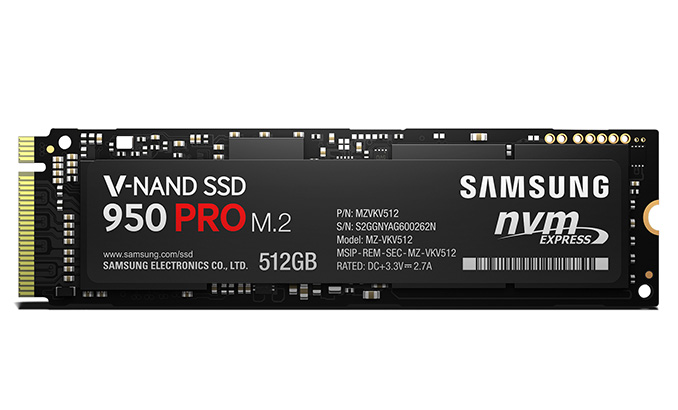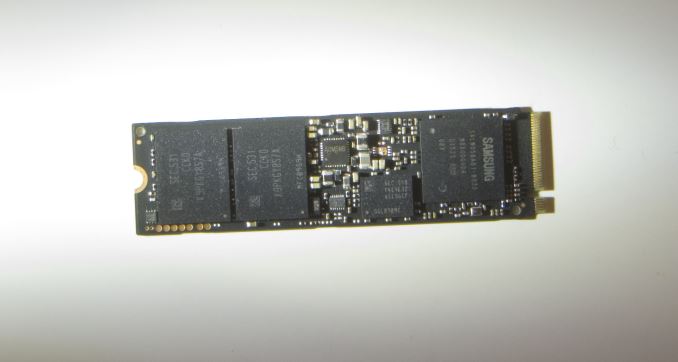The Samsung 950 Pro PCIe SSD Review (256GB and 512GB)
by Billy Tallis on October 22, 2015 10:55 AM EST
After shipping two generations of M.2 drives with PCIe interfaces for OEM customers, Samsung is releasing a PCIe drive to the retail market which has the added benefit of including the latest features Samsung offers. The Samsung 950 Pro is the new flagship consumer drive and it eschews the backwards compatibility and the 2.5" SATA form factor of the three previous iterations of the 8xx Pro family in favor of a PCI Express 3.0 x4 connection in the M.2 2280 form factor coupled with the NVMe protocol. Those changes allow for one of the biggest generational performance jumps in the history of the SSD industry and should help the transition of SSDs shedding the last vestiges and limited feature sets of their mechanical hard drive predecessors.
The M.2 2280 form factor has the potential to unify the consumer SSD market, with a physical size small enough for ultrabooks but a large enough capacity for all users. M.2, depending on the exact implementation used by the OEM, has the ability to provide SATA or high-performance PCIe connectivity, easing the transition. By supporting up to four lanes of PCIe 3.0, M.2 has helped make the two-lane SATA Express standard dead on arrival and ensures that drives won't be starving for bandwidth again for quite some time.
Meanwhile, high-end SSDs have been struggling to squeeze every last drop of performance out of the 6Gb/s SATA III interface. While some vendors have put out M.2 PCIe devices that support two lanes of PCIe, Samsung went straight for four lanes with the XP941 drive for OEMs to start. This was then upgraded to PCIe 3.0 speeds with the SM951. Earlier this year, they implemented the NVMe protocol which allows the SM951 to make use of the available bandwidth of the PCIe 3.0 x4 link. With Intel's Skylake platform bringing plentiful I/O bandwidth to support multiple lanes of PCIe 3.0 to more than just the graphics card, a good number of external bottlenecks are bypassed and Samsung can stretch the true capabilities of the hardware. This is a main focus of the 950 Pro.
| Samsung SSD Comparison | |||||
| 950 Pro 512GB |
950 Pro 256GB |
SM951-NVMe 512GB (OEM) | 850 Pro 512GB |
||
| Form Factor | M.2 2280 | 2.5" SATA | |||
| Controller | Samsung UBX | Samsung MEX | |||
| Interface | PCIe 3.0 x4 | SATA III | |||
| Protocol | NVMe | AHCI | |||
| DRAM | 512MB | 512MB | 512MB | ||
| NAND | Samsung V-NAND 32-layer 128Gbit MLC | Samsung 16nm 64Gbit MLC | Samsung V-NAND 32-layer 86Gbit MLC | ||
| Sequential Read | 2,500MB/s | 2,200MB/s | 2,150MB/s | 550MB/s | |
| Sequential Write | 1500MB/s | 900MB/s | 1,550MB/s | 520MB/s | |
| 4KB Random Read (QD32) | 300K IOPS | 270K IOPS | 300K IOPS | 100K IOPS | |
| 4KB Random Write (QD32) | 110K IOPS | 85K IOPS | 100K IOPS | 90K IOPS | |
| Power | 7.0W (burst) 5.7W (average) 1.7W (idle) |
6.4W (burst) 5.1 (average) 1.7W (idle) |
8.9W (peak) | 3.3W (read) 3.0W (write) 0.4W (idle) |
|
| Encryption | AES-256, TCG Opal 2.0 | N/A | AES-256, TCG Opal 2.0 | ||
| Endurance | 400TB | 200TB | N/A | 300TB | |
| Warranty | 5 Year | N/A | 10 Year | ||
| Launch Date | October 2015 | ~June 2015 | July 2014 | ||
The 950 Pro is using the same UBX controller as the SM951, but pairs it for the first time with 3D NAND. We first saw Samsung's 128Gb 32-layer V-NAND in the 2TB 850 Pro, introduced about a year after the original 850 Pro. None of the major components of the 950 Pro are entirely new, but this is the first consumer level product to combine them. The 950 Pro is an aggressive push forward; it's a bit risky to be bringing so much new tech in one product to the unforgiving retail market. Samsung will bear the brunt of any immaturity or incompatibilities, but they are hoping to lead the way for a much broader shift in the market.
PCI Express has been around for a long time and offers forward and backward compatibility, but until very recently most systems only offered 16 lanes from the processor, mainly for graphics cards, and one-lane slots for anything else from the chipset. With Intel's Haswell generation of processors the SATA Express connector and M.2 slot started appearing, but systems with a four-lane PCIe 3.0 connection available (and with enough overall bandwidth to fully feed it) are still quite rare. As a result, most consumers could only get that much bandwidth from one of their graphics card slots, moving any discrete graphics card to half PCIe bandwidth. This changes with Skylake and the 100-series chipsets that can support 20 PCIe 3.0 lanes of connectivity through the chipset, and up to three PCIe 3.0 x4 drives in Intel's RST mode for RAID combinations.
The 950 Pro is the new flagship, but it is certainly not a replacement for the 850 Pro. The pricing reflects that: $200 MSRP for the 256GB and $350 for the 512GB is about 50% higher than current retail prices for the 850 Pro, which is still one of the top performing consumer SSDs. Samsung is betting that the market is ready for a new premium category that's meant to be a part of the newest and fastest machines.
The 850 Pro will be sticking around in its current role, and as it's refreshed to use the 128Gb V-NAND the range of capacities will expand further, with a 4TB model of the 2.5-inch drive due in early 2016. The switch to 128Gb V-NAND may also allow prices to drop and widen the gap between the 850 Pro and the 950 Pro.
| AnandTech 2015 SSD Test System | |
| CPU | Intel Core i7-4770K running at 3.5GHz (Turbo & EIST enabled, C-states disabled) |
| Motherboard | ASUS Z97 Deluxe (BIOS 2501) |
| Chipset | Intel Z97 |
| Chipset Drivers | Intel 10.0.24+ Intel RST 13.2.4.1000 |
| Memory | Corsair Vengeance DDR3-1866 2x8GB (9-10-9-27 2T) |
| Graphics | Intel HD Graphics 4600 |
| Graphics Drivers | 15.33.8.64.3345 |
| Desktop Resolution | 1920 x 1200 |
| OS | Windows 8.1 x64 |
- Thanks to Intel for the Core i7-4770K CPU
- Thanks to ASUS for the Z97 Deluxe motherboard
- Thanks to Corsair for the Vengeance 16GB DDR3-1866 DRAM kit, RM750 power supply, Carbide 200R case, and Hydro H60 CPU cooler











142 Comments
View All Comments
SunnyNW - Saturday, October 24, 2015 - link
Actually shame on you for telling others what their priorities should be. Boot times are Very important to me and was one of the main reasons I upgraded from a hdd to a ssd in the first place. I dont want to have to wait more than the 15 seconds it takes my system to boot right now. People have to boot/restart their machine for various reasons and variable amounts of times, I dont want to have to wait more than 20 sec or so Every time I update software/drivers that require a reboot (windows update, gpu driver update, etc.). Almost every time I leave my house for more than 8 hrs or so I shut down my machine, I just dont have good luck with sleep on it, not sure if it's because of the radeon or what but ehh.Rajinder Gill - Saturday, October 24, 2015 - link
If you leave the house for 8 hours, your time cannot be worth enough money to be worried about 20 seconds of BOOT time :)SunnyNW - Sunday, October 25, 2015 - link
LOL!!! You are one Hilarious (my most polite way of saying pathetic) character. If you had any clue as to how much I Actually earn for my time, from all my various ventures especially my business, your ugly little smiles at the end of all your comments would more accurately be portrayed with a symbol that expressed your jaw wide open and hitting the floor. : 0 And how many times are you going to mention S3, lol, let me guess it's something you just recently learned about so you spout off about it Every single chance you get. Please don't reply to my comments in the future. I come here for intelligent interactions, not some nonsense from someone that has No Clue. Thank You in advance, Oh and just for you ;)Rajinder Gill - Sunday, October 25, 2015 - link
S3 resume, USE IT! One more time just for you :)xype - Monday, October 26, 2015 - link
SunnyNW, I never met one single person who made a shitload of money "with their time" who spent that time arguing online on tech sites, and arguing trivialities like SSD boot times—congrats, you’re the first!No person I know that makes $150+/hour gives a shit about boot times, and the people who do (working in IT, specifically high availability infrastructure ops) are in a whole different market from the one that AnandTech usually covers.
SunnyNW - Monday, October 26, 2015 - link
You are entitled to your opinion. But I agree, this was the first time I made a reference to my personal life finances thru comments and there is no need for that here. I just become Very annoyed when one judges others' priorities and I was already upset from other bs. Anyway not one of my finer moments.SunnyNW - Monday, October 26, 2015 - link
Lastly Ill add that 'making wrong assumptions' (especially when insulting) and 'questioning others priorities' are my pet peeves. On any other site I would not have replied in the first place. I dont know why but I feel differently when it comes to anandtechs community, I feel there is a higher standard here and many of the comments are usually very informative and worthwhile discussions. I work extremely hard and do not need someone telling me how much my time is worth. I hate when people sit behind their computer making assumptions about someone that they know absolutely nothing of, I do not expect that from the community here. I highly respect most of the commenters on anandtech and would like that in return. I feel anandtech is full of mostly intellectual persons. There are not many commenters on anandtech like mr. gill and I just let him get to me way more than I should have. Again I shouldnt have to explain myself to you but iunno here I am doing just that...I just turned 22 recently so gimme a beak, I'm learning.Rajinder Gill - Saturday, October 24, 2015 - link
If the sleep issues are due to the Radeon and BOOT time is that important, then perhaps a S3 resume complaint VGA would get you back to the desktop quicker. ;)SunnyNW - Sunday, October 25, 2015 - link
What is a "S3 resume complaint?" I have no complaints with my GPU and am very content with the 15 seconds it takes my machines to reach the desktop.ewitte - Thursday, November 12, 2015 - link
Working in IT the most annoying thing is boot times on OTHERS machines. I still run into spinning drives and insufficient memory which could be upwards of 10 minutes before performance stabilizes after a reboot.